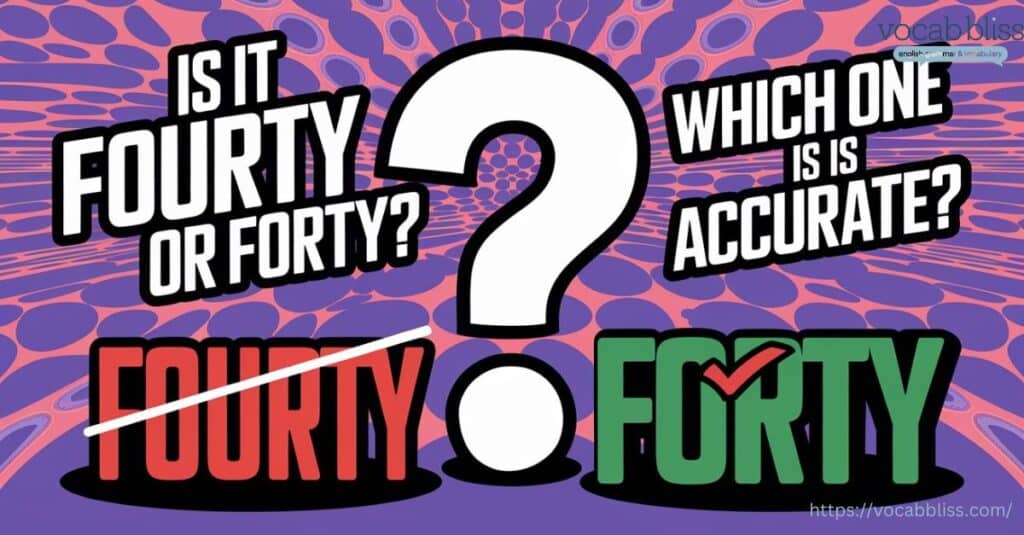If you’ve ever paused to wonder whether the correct spelling is “fourty or forty,” you’re not alone. This common confusion trips up native English speakers and learners alike. While both may seem plausible, only one is correct in modern English. Let’s dive into the fascinating history, practical usage, and tips to ensure you always spell the number 40 correctly.
Quick Summary “Fourty or Forty”
In English, the correct spelling of the number 40 is “forty,” not “fourty.” Despite the common mistake of adding an extra “u,” “fourty” is never considered correct in standard English. This spelling error likely stems from confusion with similar words like “fourteen” or the way other numbers are spelled. Historically, “forty” evolved through phonetic simplification and early printing practices, ultimately becoming the standardized form. To avoid mistakes, remember that “forty” should be used when writing about numbers, percentages, ages, and time. By following these guidelines and staying consistent, you’ll ensure your writing remains clear, professional, and grammatically correct.
Read More: Lier or Liar: Picking the Right Word
Understanding Fourty or Forty
The confusion between “forty or fourty” arises from a combination of linguistic history, phonetic similarity, and logical assumptions based on the root word “four.” While one is correct, the origins of this mix-up reveal why so many people still question the spelling of the number 40 today.
The Origins of the Confusion
At first glance, it seems logical to spell the number 40 as “fourty.” After all, its root word, “four,” includes the letter “u.” Many other number-related words follow a consistent pattern—”fourteen,” for example, retains the “u.” So why doesn’t “fourty” spelling align with this pattern?
The answer lies in the evolution of the English language. During the transition from Old English to Middle English, spelling conventions were far from standardized. The word feowertig, meaning “a group of forty,” became simplified over time. By the Middle English period, scribes began dropping unnecessary vowels in less stressed syllables. This change left us with the modern “forty” instead of “fourty.”
Spelling Variants and Historical Background
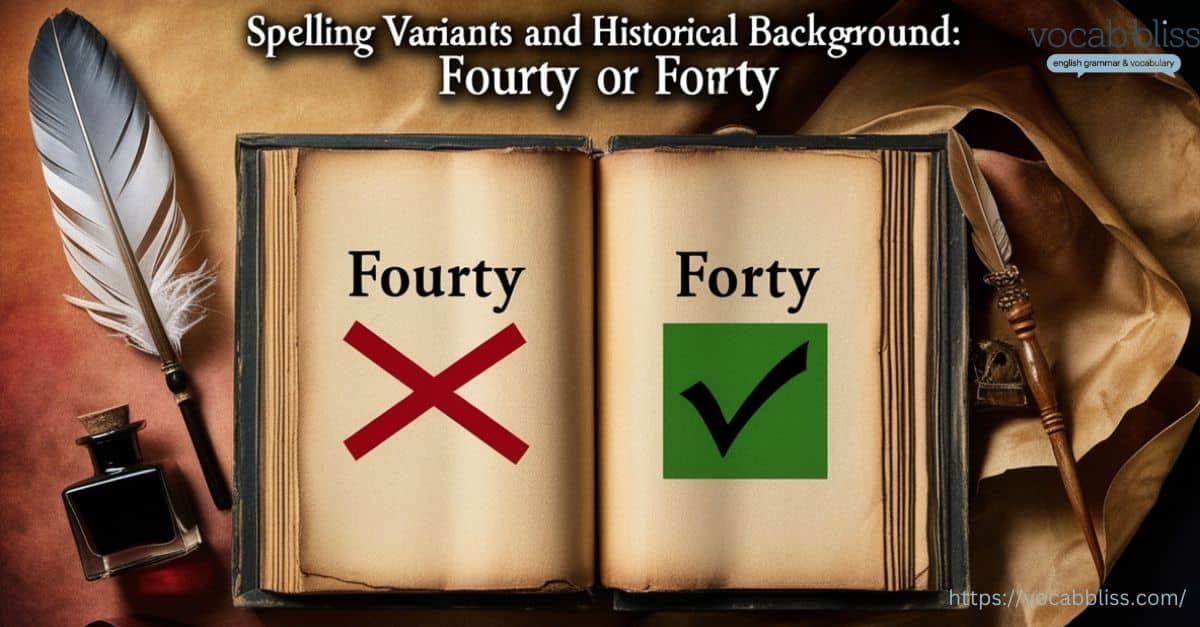
Before standardized spelling emerged in the 18th century, English words often had multiple acceptable variants. For instance, “color” and “colour” coexisted for centuries, with regional preferences dictating their usage. Similarly, some early texts featured “fourty” as a variant spelling of “forty.” However, with the advent of dictionaries and the push for consistency, “forty” became the universally accepted form.
This shift emphasizes an important point about English spelling: it doesn’t always follow logical patterns. In fact, historical influences, regional dialects, and even the whims of early lexicographers have all played a role in shaping the language we use today.
How to Spell Out “40 forty or fourty”?
When writing the number 40, the correct spelling is always “forty.” Despite its logical appearance, “fourty” is a misspelling and is not accepted in standard English. Understanding the distinction between these two forms can help you avoid this common mistake.
The Correct Spelling: “Forty”
The word “forty” is the only correct way to spell the number 40 in English. While it may seem inconsistent with the spelling of its root, “four,” this is simply a quirk of the language’s evolution. The absence of the “u” in “forty” dates back to historical shifts in English spelling conventions, as words were streamlined to match their pronunciation.
- Example of Correct Usage:
- “The event lasted forty minutes.”
- “There are forty students in the class.”
The Common Misspelling: “Fourty”
It’s easy to see why “fourty spelling” is so prevalent. The logical association with “four” leads many people to mistakenly include the “u” in the word. However, “fourty” is not recognized in modern English and should be avoided in both formal and informal writing.
- Example of Incorrect Usage:
- “The event lasted fourty minutes.” (Incorrect)
Why Does This Mistake Happen?
The misspelling “fourty” often stems from these factors:
- Phonetic Similarity: “Four” and “forty” sound similar, leading writers to assume they share the same spelling structure.
- Inconsistent English Rules: English is full of irregularities, and the divergence between “four” and “forty” adds to the confusion.
- Lack of Awareness: Many people are simply unaware that “fourty” is incorrect.
How to Remember the Correct Spelling
To avoid this common error, keep these tips in mind:
- Mnemonic Device: “Forget the ‘u’ when spelling forty.”
- Visual Reminder: Picture the word “forty” on a digital clock showing 40 minutes past the hour.
- Practice: Incorporate “forty” into your writing more frequently to reinforce the correct spelling.
How Forty Lost Its ‘U’
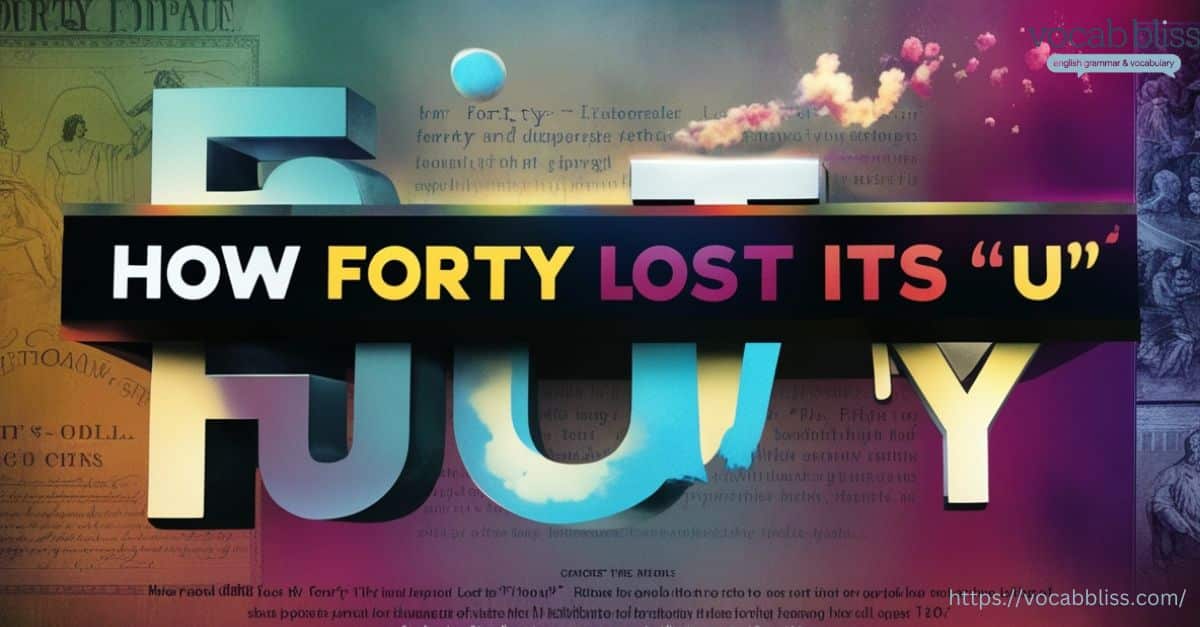
The spelling of “forty” might seem puzzling at first glance. Why does it drop the “u” from its root word, “four”? This inconsistency, while confusing, is a product of linguistic evolution and the natural simplification of English over time.
The Linguistic History of “Forty”
The word “forty” traces its origins to Old English, where it was spelled feowertig. This term was a compound of feower (meaning “four”) and tig (a suffix indicating multiples of ten). Over time, as the English language transitioned through the Middle English period, both spelling and pronunciation underwent significant changes. Consequently, feowertig evolved into the modern spelling of forty, which we use today.
During this time, the Old English feowertig began to evolve into forms like forti and fourty. Both versions coexisted for a while, but as phonetic simplification became a dominant trend, “forty” emerged as the standard spelling.
Why Did “Forty” Deviate from “Four”?
The divergence between “forty or fourty” reflects broader trends in English orthography:
- Phonetic Simplification: Over time, non-essential letters were often dropped to make words quicker to write and easier to pronounce. The “u” in “fourty” was likely removed because it was less stressed in speech.
- Early Printing Practices: The rise of the printing press in the 15th century also played a role. Printers favored simpler, more economical spellings to save space and standardize texts.
- Dictionary Standardization: By the 18th century, lexicographers like Samuel Johnson formalized English spelling. They solidified “forty” as the correct form, eliminating “fourty” from formal usage.
The Impact of Phonetic Simplification on Modern English
Phonetic simplification has left a lasting imprint on English spelling. Words like “night” (from Old English niht) and “light” (from liht) also dropped unnecessary letters over time. In the case of “forty,” this simplification streamlined the word but created a minor irregularity in relation to “four.”
While this historical shift may seem illogical, it reflects the organic, often inconsistent nature of English as a living language. Understanding this context helps explain why “fourty” spelling feels intuitive yet remains incorrect.
Why is “Fourty” So Common?
The prevalence of “fourty” as a misspelling stems from its intuitive appearance. Since “four” contains a “u,” it feels natural to include it when writing the number 40. Additionally, regional dialects and variations in pronunciation may contribute to the confusion.
In reality, “fourty” vs. “forty” isn’t a regional difference—English speakers worldwide recognize “forty” as the only correct spelling.
fourty or forty: A Side-by-Side Comparison
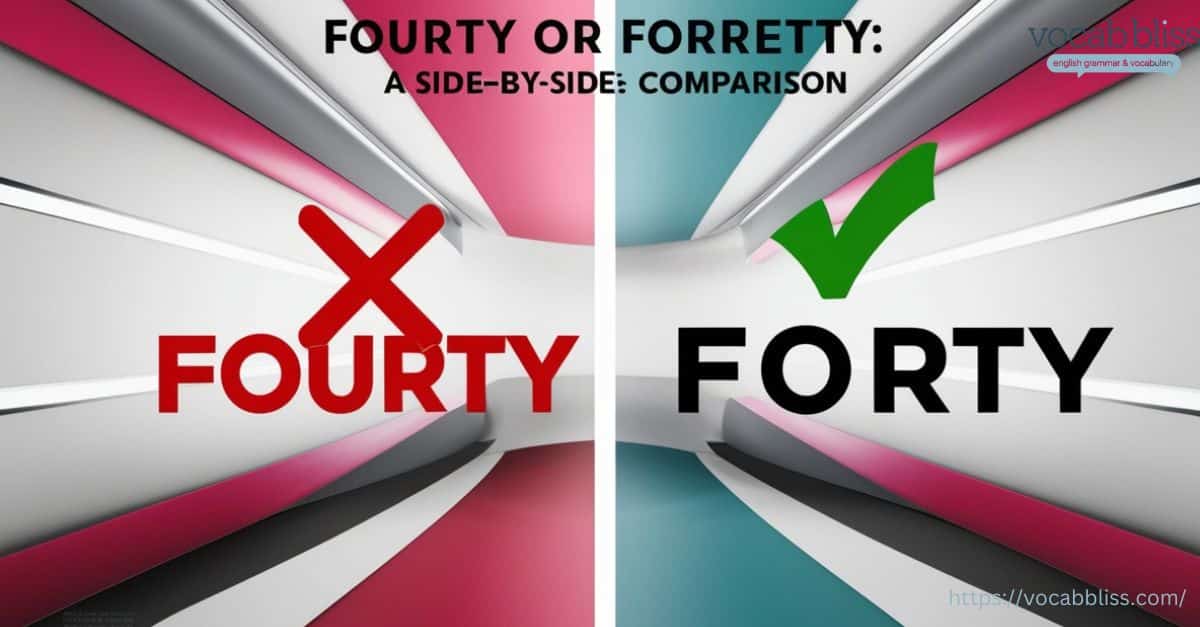
To clarify the distinction between “forty or fourty,” let’s compare their correctness, usage, and examples in a simple table format.
| Term | Correct? | Examples |
|---|---|---|
| Forty | ✅ Yes | “I turned forty yesterday.” |
| Fourty | ❌ No | “He is fourty years old.” (Incorrect) |
Why “Forty” is Correct
- It adheres to standardized English spelling conventions.
- Recognized universally in dictionaries and formal texts.
Why “Fourty” is Incorrect
- It deviates from established spelling rules.
- Not accepted in modern English usage, despite its logical appearance.
Practical Examples in Context
- Correct: “The recipe calls for forty ounces of flour.”
- Incorrect: “The recipe calls for fourty ounces of flour.”
- Correct: “She bought forty candles for the celebration.”
- Incorrect: “She bought fourty candles for the celebration.”
Everyday Usage Examples Fourty or Forty
Let’s dive into how the correct spelling “forty” is used in everyday sentences and how the common mistake “fourty” might appear. For instance, seeing these examples in context can help solidify the distinction. Additionally, understanding the difference through real-life examples will make it easier to remember the proper spelling moving forward.
Correct Sentences Using “Forty”
Here are examples where “forty” is correctly applied:
- “She turned forty last month and threw a big party to celebrate.”
- “The speed limit on this highway is forty miles per hour.”
- “There are forty students enrolled in the workshop this semester.”
- “The cake recipe calls for forty grams of sugar.”
- “After working in the field for forty years, he decided to retire.”
Incorrect Sentences Using “Fourty”
Below are examples where “fourty” appears incorrectly:
- “The sign said the road could hold up to fourty tons.” (Incorrect)
- “She has been teaching for over fourty years.” (Incorrect)
- “I scored fourty points in the game!” (Incorrect)
Why People Make This Mistake
Misusing “fourty” is often a result of:
- Phonetic similarity to “four.”
- Assumptions based on spelling consistency, as “fourteen” includes a “u.”
- Lack of exposure to the standardized rules of English spelling.
Quick Tip to Avoid Errors
Always remember: “Forty” forgets the ‘u’! This simple mnemonic can save you from making this common mistake.
How to Use Forty in a Sentence
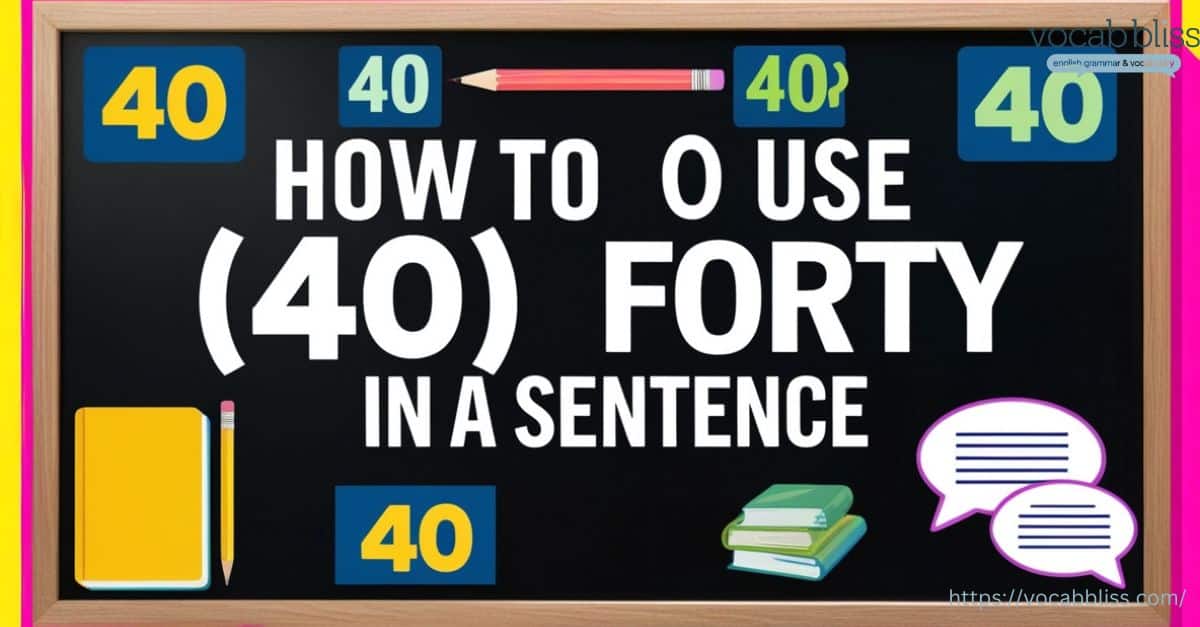
Knowing how to correctly use “forty” in written and spoken English can elevate the accuracy and professionalism of your communication. Here are practical tips and examples to ensure you’re using the number 40 spelling correctly in every context.
Tips for Using “Forty” Correctly
- Numbers in Words: Use “forty” when spelling out the number in formal writing, such as essays, official documents, or literature.
- Example: “Forty students attended the lecture.”
- Percentages and Discounts: The word “forty” is often used when describing percentages, especially in promotional or financial contexts.
- Example: “The store offers a forty-percent discount during the sale.”
- Ages and Milestones: Spell out “forty” to refer to someone’s age or significant milestones.
- Example: “He celebrated his fortieth birthday with family and friends.”
- Time and Duration: Use “forty” to describe periods of time.
- Example: “The meeting lasted forty minutes longer than expected.”
Examples of “Forty” in Context
- “She ran forty miles this week as part of her training regimen.”
- “The team scored forty points in the final game.”
- “It took them forty days to complete the project.”
- “The antique chair is valued at forty dollars.”
Common Scenarios for Misuse
Even when writing about everyday topics, some people mistakenly use “fourty” in place of “forty.” Avoid these pitfalls by always proofreading your work for accuracy.
- Incorrect: “He bought the table for fourty dollars.”
- Correct: “He bought the table for forty dollars.”
Quick Test to Practice
Use these fill-in-the-blank exercises to reinforce your understanding:
- The package weighs _____ pounds. (Answer: Forty)
- The program promises a _____-percent success rate. (Answer: Forty)
- She bought a gift for _____ dollars. (Answer: Forty)
Incorporating “forty” into your writing and speech with confidence ensures clear and professional communication. Always remember: “Forty” is the only correct way to spell the number 40 in English.
Tips to Remember the Correct Spelling
For those who struggle with spelling the number 40, here are some simple tricks:
- Mnemonic Devices:
- “The ‘u’ in four disappears in forty.”
- Visual Memory: Picture the word “forty” next to a clock showing 40 minutes past the hour.
- Spell-Check Tools: Use apps or tools to catch errors like “fourty spelling.”
These strategies can save you from embarrassment in professional or academic writing.
Check for Common Mistakes
Mistakes like “fourty” can often slip past unnoticed, especially in casual writing. Here’s how to catch them:
- Use Spell-Checking Tools: Most word processors will flag “fourty” as incorrect.
- Proofread Carefully: Pay extra attention when writing numbers in text.
- Cross-Reference Reliable Sources: Look up correct spellings if you’re unsure.
By following these practices, you’ll ensure that your writing stays precise and polished.
Other Interesting Language Articles
Interested in improving your language skills further? Check out these related topics:
- Commonly Misspelled Numbers in English
- The Difference Between “Their” and “There”
- Why English Spelling is So Complicated
Frequently Asked Questions (FAQs)
Is “fourty” a correct spelling?
A: No, “fourty” is not correct. The only accepted spelling is “forty.”
Why does “forty” drop the “u”?
A: Historical phonetic changes led to the omission of the “u” when the word evolved from Old English to modern English.
How can I remember the spelling of 40?
A: Use a mnemonic like “The ‘u’ in four disappears in forty.”
Fourty or forty which is correct?
A: The correct spelling is forty. “Fourty” is a common misspelling and should be avoided. The word forty has been the standard spelling in English for centuries, while fourty is never considered correct. Always use forty when writing or speaking about the number 40.
Conclusion
When it comes to the number 40, “forty” is the only correct spelling in English. While “fourty” might seem logical based on other number words, it is a common misspelling that doesn’t conform to the rules of the language. Historically, the word “forty” evolved through language changes and printing practices, and over time, it became the standardized form we use today. This makes understanding the spelling of 40 in English crucial not only for clarity but for maintaining the integrity of the language.
In everyday usage, whether you’re writing about percentages, ages, or durations, always opt for forty to avoid confusion and errors. By following the correct spelling, you ensure precision in your writing, especially in professional or academic contexts. Remember, fourty or forty isn’t just about spelling—it’s about adhering to proper writing conventions and showcasing your attention to detail.
So, next time you find yourself writing about the number 40, make sure to use forty and leave fourty behind. This simple adjustment can enhance the accuracy and credibility of your work.
Continue reading:
- skillset or skill set, Skill-Set,: Which is Right?
- Kart vs Cart: Appropriate Use and Context
- ballon or balloon: Solving the Spelling Issue
- High Quality or High-Quality: Which One Should You Use?

Jorge Phillips is an experienced blogger who writes for Vocab Bliss, sharing his passion for the English language. With a knack for simplifying complex grammar rules and a focus on commonly confused words, Jorge helps readers navigate the nuances of English with ease. His insights aim to make learning engaging and practical.

